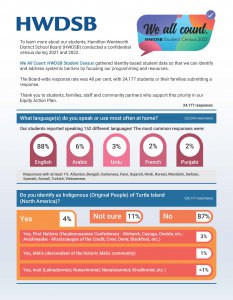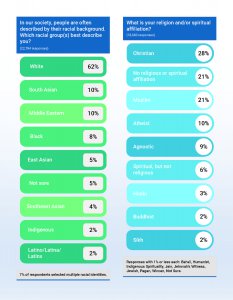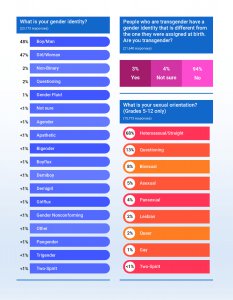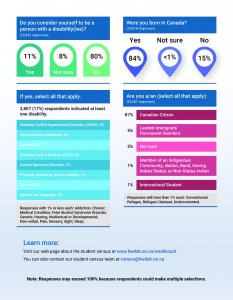
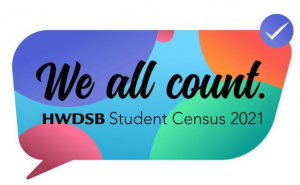 In April 2021, HWDSB conducted a confidential census to learn more about students by gathering identity-based student data. This data was collected to help HWDSB identify and address systemic barriers that exist in the organization.
In April 2021, HWDSB conducted a confidential census to learn more about students by gathering identity-based student data. This data was collected to help HWDSB identify and address systemic barriers that exist in the organization.
Due to challenges incurred during the remote learning period in the 2020-2021 school year, the student census was reintroduced in 2021-2022.
Census Results
- Media Release: HWDSB Shares Results of First Student Census, We All Count
- Infographic: Student Census 2022 Infographic
|
Please see a copy of the student census questionnaire below, for information only.
Student Census Question Guide – explore each question
| Kindergarten to Grade 4 Student Census – English | Grade 5 to 12 Student Census – English |
What is the census and what did it ask?
We all Count: HWDSB Student Census is a voluntary and confidential student survey that collects identity-based data to identify and address systemic barriers. The nine questions on the census ask about a student’s languages, Indigenous identity, ethnicity, race, religion, gender identity, sexual orientation, (dis)abilities, place of birth and citizenship/immigration status.
These questions are consistent with sample questions provided through the Anti-Racism Data Standard established through the Anti-Racism Act with a goal to identifying and addressing inequities in student opportunities and achievement outcomes. To see the survey, please visit www.hwdsb.on.ca/weallcount.
Why did HWDSB conduct a student census?
Many school boards have conducted a student census. In fact, the Anti-Racism Act, 2017 (hwdsb.info/36SHsuI) and Ontario’s Education Equity Action Plan (hwdsb.info/2Lwiie2) require school boards to gather and report this data. The Ontario Human Rights Commission (OHRC) finds that data collection can play an essential role to creating equitable outcomes and strong human rights strategies by helping organization identifying gaps in services.
At HWDSB, the census is one of the priority projects in our Equity Action Plan (hwdsb.info/equityplan) The data will help us understand the needs of students and families, identify, and address systemic barriers, and make evidence-informed decisions that create more equitable outcomes.
How did it occur?
- Students in Kindergarten to Grade 4: We emailed families a secure link to the census form so they could complete the census form online on behalf of their child. Print copies were available by request to [email protected].
- Students in Grades 5 to 12: We emailed a secure link to students in grades 5 to 12, so they could complete the census form online during class time, with teacher support. Print copies were available by request to [email protected].
How will the data be used?
We will use the data to understand the make-up of the HWDSB student population, and to produce reports on student achievement, opportunities, and participation in programming. By identifying trends and gaps, we will be able to see which groups are over- or under-represented in certain areas. HWDSB will use this trend analysis to focus its work to improve school environments, eliminate discriminatory practices and remove barriers to student success. We will publicly report census results and how this data has helped guide HWDSB programs, strategies, policies, practices, resources, and supports.
How will HWDSB protect students’ personal information?
HWDSB is committed to the highest levels of privacy and confidentiality when collecting information about students and families. Student census data is collected under the authority of the Anti-Racism Act, 2017, S.O. 2017, c. 15, the Education Act, R.S.O. 1990, c. E.2, and complies with the Municipal Freedom of Information and Protection of Privacy Act, R.S.O. 1990, c. M.56.
The student census is confidential, but it is not anonymous. Individual student responses will be grouped together for analysis so that no individual student information is ever identifiable. Collected responses will be stored in a secure, confidential database and will only be accessed by authorized HWDSB Research & Analytics staff to identify and summarize trends among HWDSB students.
Here is a description of our data security and practices that relate to the Census:
- Data is collected using an online survey tool, SurveyMonkey (Enterprise version). Data is stored in Canadian data centres. SurveyMonkey is SOC 2 accredited, has 24×7 monitoring, entry requirements, access logs, hardware in dedicated cages. Data is encrypted in transit and at rest; responses are transmitted via encrypted TLS. User logins are protected via TLS. Access controls are in place and NDAs; annual privacy & security training. There is a vulnerability management program in place including internal and external penetration testing.
- Once the Census closes, Research & Analytics will download (onto encrypted USB) the primary data and delete it from the account and request deletion from SurveyMonkey servers.
- We will follow the protocol we developed for another project involving sensitive data: primary Census data will be loaded onto a dedicated laptop (then USB wiped) that is not internet or network enabled, and backed up on a dedicated, encrypted (256-bit AES) external hard drive. They will be stored in a locked filing cabinet in the Data Scientist’s locked office inside the Research & Analytics Department which requires a swipe card to enter.
- One person, the Data Scientist, has access to the encrypted data.
- The Data Scientist is responsible for linking datasets and then removing the primary key before sharing the new datasets with the Research Officer and Research Analyst in the Research & Analytics Department for analysis.
- No data, with or without the primary key will leave the Research & Analytics Department. Only summary reports and aggregate data tables will leave the department.
- Nobody has administrative access to the primary data. The Data Scientist will ensure the Research and Analytics Manager has access to the laptop and hard drive passwords for back-up purposes only.
- Suppression rules apply to all Research & Analytics reporting. In other words, where cell counts are low (<5), the data is suppressed. We may increase the suppression threshold if we deem the data too sensitive.
Was it mandatory?
Completing the census was voluntary. However, we asked students to participate so we get an accurate picture of our student population. A high response rate will better help us identify barriers, create strategies, and make informed decisions to address barriers to student achievement and well-being. Families who did not want their child to participate could opt out using a form on the Parent Portal.
How was the HWDSB student census developed?
HWDSB’s student census questions are consistent with sample questions in the Anti-Racism Data Standard of the Anti-Racism Act. These questions are used to identify and address inequities in student opportunities and achievement outcomes. Locally, the census was guided with substantial input from a wide variety of student, families, staff, and community members. We held consultations to gather community feedback and followed best practices for student census planning, development, analysis, and the application of results.
Was the census available for students with special education needs?
Yes. Depending on students’ needs, we provided necessary accommodations like supportive and assistive technology so every student can participate. Support staff such as educational assistants also provided support as required. We helped arrange support so that families can complete the census on behalf of students whose special education needs made it a challenge to do the survey on their own.
Was the census available in languages other than English?
Yes, the census was available in French and 10 of the most common languages reported at HWDSB: Arabic, Chinese, Farsi, Karen, Kurdish, Korean, Somali, Spanish, Urdu and Vietnamese. Audio reading was available for families with children in grades Kindergarten to Grade 4, and for English Language Learners in grades 5 to 12 with limited literacy in these languages. For other languages, interpreters could be requested by families, SWIS workers and/or educators by emailing [email protected] or contacting the school.
Who will own this data?
Personal information always belongs to the individuals who submitted it. The board is the caretaker of that data and will use it for the purposes stated in the collection information communicated to parents and students. The data will physically reside in the Research & Analytics Department with one staff member, the Data Scientist, responsible for securing the original data, linking data sets and removing identifiers before sharing with the Research Officer and Research Analyst for analysis. Only those three will have access to data.
Will you attempt to correlate a student’s ethnic background to her/his performance, behaviour, mental health, etc.? Where do you draw the line on data mining practices? And will you be sharing survey-generated data with third parties?
We will never look at individual students using this data. Once the census data has been linked with datasets containing achievement, well-being, suspensions/expulsions, the primary key (the identifier used to link the datasets) is deleted. No identifiers will exist in the new datasets, suppression rules will be applied so that we do not report where cell sizes are too small, and only summary reports and aggregate tables will leave the Research & Analytics Department for use by board staff.
The survey data is collected using a third-party platform which has been vetted for industry standard security measures, practices and human resources. Once collected, we will download and delete the data from the platform and request from the company that it be deleted from their servers.
How long will the data be stored? Why not delete student data after a student graduates?
We typically store research data for 5 to 7 years which is standard for research. The census data won’t be useful to us for long so we will securely destroy it after 5 years. We will keep the dataset whole despite students graduating because we will be analyzing it over time, and we may go back and look at past data in response to new research questions. Yes, we are interested in understanding our current student body, but the data will enable us to see barriers that reflect changes that need to be made in the system, regardless of whether a student who completed the census has now graduated.
If someone took the survey and decided they no longer want the responses to be used, can they request the responses be deleted?
We honour individuals’ right to change their consent. If they consented to fill in the census and then change their mind later, they can email [email protected] to request that their data be removed from the dataset. We can remove it from the original dataset but once the data has been linked with other datasets for analysis and the student identifier removed, we will not be able to remove their data from those merged datasets because we have no idea of knowing which data is theirs.
Hacking and data breaches have become increasingly common, and schools are specifically being targeted. If there is a data breach, what is the process for recovering the data and protecting student identities? How will families be notified and/or compensated?
We have purposefully worked out a method for handling the census data that almost completely eliminates the possibility of an electronic data breach. Once the data has been collected by our survey tool, it will be downloaded from the online servers and stored on an encrypted hard drive and laptop, neither of which are internet or network enabled. The hardware will reside in a locked filing cabinet in the locked office of our Data Scientist in the Research & Analytics Department which requires a swipe card to enter. We have a process for working through breaches that you can see here.
Why did we ask about status in Canada?
HWDSB’s student census questions are consistent with sample questions in the Data Standards for the Identification and Monitoring of Systemic Racism. Locally, the census was guided with input from consultation with students, families, staff, and community members. We held consultations to gather community feedback and followed best practices for student census planning, development, analysis, and the application of results.
Collecting identity-based/human rights-based data in school boards and other public agencies is not only allowed; it is required. Collecting student data is not new as legislated by the Education Act as long as the purpose is to improve student achievement, well-being and so on.
Most recently, through the Anti-Racism Act, 2017, school boards (and other public agencies including health, police, Children’s Aid Societies, etc.) are mandated to collect this data for the purpose of identifying and addressing inequities.
The Ministry of Education has also made this a priority for school boards through the Ontario’s Education Equity Action Plan. collecting data on Code grounds for a Code -consistent purpose is permitted, and is in accordance with Canada’s human rights legislative framework, including the Code In conducting this student census, HWDSB is following the Ontario’s Anti-racism Data Standards and ORHC’s Count me in: Collecting Human Rights-Based Data. The OHRC states that “collecting data on Code grounds for a Code -consistent purpose is permitted and is in accordance with Canada’s human rights legislative framework, including the Code.”
Regarding the question on status in Canada, we ask this because students who are not born in Canada, and/or are newcomers or immigrants, face different challenges accessing education. Collecting student information about their status in Canada and how that may intersect with their experiences in school helps to identify, monitor, and address systemic discrimination and disparities in services and outcomes that students may experience due to their immigration status and place of birth.
Regulations under the Anti-Racism Act may require or authorize school boards to collect the following personal information:
- Indigenous Identity
- Race
- Ethnic origin
- Religion
- Age
- Sex
- Education
- Geospatial information, such as postal code for place of residence, or place of work
- Socio-economic information, such as educational level, annual income, employment status, occupation, or housing status
- Citizenship
- Immigration status
- Gender identity and gender expression
- Sexual orientation
- Place of birth
- Languages
- Marital status
- Family status
- (Dis)abilities
How accurate is the data you collected?
Reporting on potential issues affecting data quality is required by Ontario’s Anti-Racism Data Standards. The most important source of bias in this project is non-response selection bias. The sample collected is sufficiently large to estimate the prevalence of the identity-based sociodemographic characteristics with a small margin for error, however, the sample differs from that of a typical survey in that it was not selected randomly. Each student had an opportunity to participate, but the response rate was still fairly low (45%). The students and parents who did not participate, then, may differ from the study sample on one or more of the demographic variables assessed. The kindergarten to grade four sample is particularly prone to this selection bias, as only one in four parents (26%) completed the questionnaire.
There is some indication that some questions were not understood or were misinterpreted by some respondents. There were some technical errors in both the Parent Portal and the survey tool used to collect the data. For example, questions with two parts were concatenated and, in some cases, not discernable between the response to the first part of the question and the response to the second. Unique links were used by multiple students, in some cases.
These data quality and data collection issues were resolved by the Research and Analytics team and their impact on the project mitigated but this impacts our ability to meet Ontario’s Anti-Racism Data Standards for timely release of results to maintain public confidence in the research.
This project was undertaken to collect, analyze, and publicly report on identity-based data for evidence-informed decision-making to support equity of access and outcomes for all students. The results from the first wave of the HWDSB Student Census provide population estimates of identity-based sociodemographic data that can inform a clearer understanding of who our students are. The lessons learned from this project will help improve data collection for the next iteration of the student census to better represent students, identify and monitor systemic inequities to improve service delivery and better meet student needs.
What if I have questions?
If you have questions, please contact our student census team at [email protected].
Student Census Glossary 2021
Please see a list below of terms and definitions used in the HWDSB student census. If you would like a term added to the list, please email [email protected]
ASEXUAL: Refers to a person that experiences no sexual attraction to others.
BIGENDER: Refers to a person who identifies as having two genders. (Source: OPS Bilingual Glossary on Gender Identity (gov.on.ca))
BISEXUAL: Refers to a person who is physically/sexually and emotionally attracted to both males and females.
CISGENDER: Refers to a person whose gender identity aligns with what is typically associated with their sex assigned at birth. (Source: OPS Bilingual Glossary on Gender Identity (gov.on.ca))
CITIZENSHIP: Refers to the legal citizenship status of a person. Canadian citizenship can be obtained by birth (If one was born in Canada or born outside of Canada and at least one parent was born in Canada or naturalized in Canada before one’s birth) or by naturalization (The process through which immigrants acquire Canadian citizenship. Landed immigrants who have met certain criteria are eligible for Canadian citizenship by naturalization. The criteria for acquiring citizenship generally include a residency requirement, knowledge of English or French, and basic knowledge of Canada. (Source: Obtaining Canadian citizenship (statcan.gc.ca))
DATA: Data consists of facts, figures, and statistics objectively measured according to a standard or scale, such as frequency, volumes or occurrences, but does not include information. (Source: Data Standards for the Identification and Monitoring of Systemic Racism (ontario.ca)
DE-IDENTIFY: In relation to the information of an individual, means to remove any information that identifies the individual or for which it is reasonably foreseeable in the circumstances that it could be utilized, either alone or with other information, to identify the individual. (Source: Data Standards for the Identification and Monitoring of Systemic Racism (ontario.ca)
DISAGGREGATED DATA: Disaggregated data is broken down into component parts or smaller units of data for statistical analysis. In the context of race-based data, this means breaking down the composite (aggregate) “racialized” category into its component parts such as Black, South Asian, East/Southeast Asian, Latino, Middle Eastern, White, etc. (Source: Data Standards for the Identification and Monitoring of Systemic Racism (ontario.ca))
ETHNICITY/ETHNIC GROUPS: Refers to a person’s ethnic or cultural origins. Ethnic groups have a common identity, heritage, ancestry, or historical past, often with identifiable cultural, linguistic, and/or religious characteristics. (Source: Data Standards for the Identification and Monitoring of Systemic Racism (ontario.ca). Other than Indigenous persons, most people in Canada can trace their origins to their ancestors who first came to Canada. Ethnic origin refers to a person’s ‘roots’ and should not be confused with citizenship, language or place of birth. For example, a person who has Canadian citizenship, speaks Punjabi and was born in the United States may report Guyanese ethnic origin.
INDIGENOUS SPIRITUALITY: The Ontario Human Rights Commission defines “Indigenous Spirituality” as the spiritual beliefs and practices that Indigenous peoples identify as being “traditional” or “customary” among Indigenous peoples. This may sometimes include and be practiced in combination with other faith traditions, such as Christianity.
INTERSEX: Refers to a person born with reproductive systems, chromosomes or hormones that are not easily characterized as male or female. (Source: OPS Bilingual Glossary on Gender Identity (gov.on.ca)
LESBIAN: Refers to a female who is attracted physically/sexually and emotionally almost exclusively to other females. (Source: GLAAD Media Reference Guide – Lesbian / Gay / Bisexual Glossary of Terms – GLAAD)
MENTAL HEALTH: Mental health is characterized by an individual’s ability to cope with the stresses of everyday life, work productively and contribute positively to society all while recognizing their own abilities. (Source: Mental Health (CMHA Ontario))
MENTAL ILLNESS is a recognized, medically diagnosable illness that results in the significant impairment of an individual’s cognitive, affective or relational abilities. Mental disorders result from biological, developmental and/or psychosocial factors and can be managed using approaches comparable to those applied to physical disease (i.e., prevention, diagnosis, treatment and rehabilitation). (Source: Mental Health (CMHA Ontario))
NON-BINARY: Refers to a person whose gender identity does not align with the binary concept of gender such as man/boy or woman/girl. (Source: OPS Bilingual Glossary on Gender Identity (gov.on.ca)
QUEER: Refers to a person whose sexual orientation or gender identity goes against the heteronormative social model. (Source: OPS Bilingual Glossary on Gender Identity (gov.on.ca)
QUESTIONING: Refers to a person who is unsure about their own gender identity or sexual orientation. (Source: OPS Bilingual Glossary on Gender Identity (gov.on.ca)
RACE: is a term used to classify people into groups based principally on physical traits (phenotypes) such as skin colour. Racial categories are not based on science or biology but on differences that society has created (i.e. “socially constructed”), with significant consequences for people’s lives. Racial categories may vary over time and place and can overlap with ethnic, cultural or religious groupings. (Source: Data Standards for the Identification and Monitoring of Systemic Racism (ontario.ca)
RELIGION: Religion is any religious denomination, group, sect, or other religiously defined community or system of belief and/or spiritual faith practices. (Source Data Standards for the Identification and Monitoring of Systemic Racism (ontario.ca)
SEXUAL ORIENTATION: The scientifically accurate term for an individual’s enduring physical, romantic and/ or emotional attraction to members of the same and/or opposite sex, including lesbian, gay, bisexual, and heterosexual (straight) orientations. (Source: GLAAD Media Reference Guide – Lesbian / Gay / Bisexual Glossary of Terms – GLAAD)
SOCIALLY CONSTRUCTED: Meaning that is not inherently true, but agreed upon by society. Once society agrees to this meaning, it becomes real in its consequences for people’s lives. (Source: Is Everyone Equal?: an introduction to key concepts in social justice education/ Ozlem Sensoy, Robin DiAngelo)
TRANSGENDER: An umbrella term for people whose gender identity and/or expression is different from cultural expectations based on the sex they were assigned at birth. Being transgender does not imply any specific sexual orientation. Therefore, transgender people may identify as straight, gay, lesbian, bisexual, etc. (source: https://www.hrc.org/resources/glossary-of-terms)
TRIGENDER: Refers to a person whose gender identity shifts between three genders (man, woman or any non-binary identity).
TURTLE ISLAND is the name many Algonquian- and Iroquoian-speaking peoples mainly in the northeastern part of North America use to refer to the continent. In various Indigenous origin stories, the turtle is said to support the world, and is an icon of life itself. (Source: www.thecanadianencyclopedia.ca.)
TWO-SPIRIT: An Indigenous person whose gender identity, spiritual identity or sexual orientation includes masculine, feminine or non-binary spirits. (Source: OPS Bilingual Glossary on Gender Identity (gov.on.ca))
Updated on Thursday, November 23, 2023.


